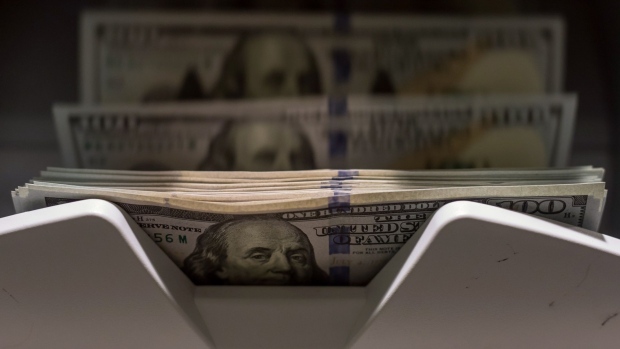Mar 24, 2023
US Bank Deposits Fall Most in Nearly a Year After SVB Collapse
, Bloomberg News

(Bloomberg) -- Deposits at US lenders posted the biggest decline in nearly a year during the week when multiple bank failures triggered the latest bout of global financial turmoil.
The decline was entirely due to a record plunge in deposits at smaller institutions.
Bank deposits fell by $98.4 billion to $17.5 trillion in the week ended March 15, according to data released Friday by the Federal Reserve. Deposits at small banks slumped $120 billion, while those for 25 largest firms rose almost $67 billion.
So-called “other” deposits, which exclude accounts with maturity dates such as certificates of deposit, declined by $78.2 billion to $15.7 trillion. Compared with a year ago, these more liquid deposits such as savings and checking accounts have declined by 6.1%, the most in data back to the early 1970s.
- Bank credit, on a seasonally adjusted basis, rose $73.5 billion to $17.6 trillion
- Total assets, which includes vault cash, as well as balances due from depository institutions and the Fed, jumped $430.5 billion to $23.2 trillion, marking the largest gain since the immediate aftermath of the pandemic
- Total liabilities surged more than $412 billion to $21.1 trillion
- Commercial and industrial lending — considered a gauge of economic activity — rose $20 billion to $2.83 trillion
Institutions had already been seeing a steady outflow of deposits that was driven by more attractive rates elsewhere. When concerns about the banking system began to spread quickly, so did withdrawals. Many depositors plowed into money-market funds. More than $117 billion poured into those accounts in the week ended March 22, according to data from the Investment Company Institute.
The Fed’s weekly snapshot of US banks has suddenly emerged as a key data point for markets and the economy in the wake of the collapse of Silicon Valley Bank and several other lenders. Despite still-developing credit-market concerns, policymakers this week pushed forward with their ninth-straight interest-rate this week as they seek to extinguish still-rapid inflation.
“The US banking system is sound and resilient,” the Fed said in a statement in Washington after a two-day meeting, though warned that “recent developments are likely to result in tighter credit conditions for households and businesses and to weigh on economic activity, hiring, and inflation. The extent of these effects is uncertain.”
US authorities responded to the bank failures by taking extraordinary measures to shore up confidence in the financial system by introducing a new backstop for banks that projected to be big enough to protect the entire nation’s deposits.
The speed with which four banks collapsed — in the space of just 11 days — has left investors reeling and early indications show that banks have tightened lending standards as they seek to shore up their own finances, choking off the flow of loans that helps lubricate economic growth.
“It’s a complete game changer from what we’ve seen before,” Citigroup Inc. Chief Executive Officer Jane Fraser said on Wednesday in an interview with Carlyle Group Inc. co-founder David Rubenstein at an Economic Club of Washington event.
“There were a couple of Tweets and then this thing went down much faster than has happened in history. And frankly I think the regulators did a good job in responding very quickly because normally you have longer to respond to this.”
Overall bank lending rose by $63.4 billion by $12.2 trillion in the week through March 15, the latest Fed data show.
The biggest 25 domestic banks account for roughly three-fifths of lending, but in some key areas — including commercial real estate — smaller banks are the most important providers of credit.
Dash for Cash
After the collapse of SVB, the Fed offered additional backstops for lenders in need of liquidity. Banks borrowed a combined $165 billion from two new facilities, according to separate data released on Thursday, a sign of escalated funding strains.
Altogether, the surge of emergency borrowing added some $440 billion in reserves to the Fed’s balance sheet in a matter of days — reversing the shrinkage that had taken place under the policy known as quantitative tightening, launched in June last year.
Before that injection of support, the cash assets held by banks — as a share of their total assets — had fallen to the lowest levels in three years.
The Fed’s report on assets and liabilities of commercial banks, known as H.8, includes breakdowns of credit by destination — such as consumer, real estate and commercial loans — as well as categories based on bank size.
(Adds deposits at small banks. A previous story was corrected to remove reference to unadjusted data in the second paragraph.)
©2023 Bloomberg L.P.





